In this emerging world of modern design of structures, Concrete acts as the backbone of civil engineering. A structural engineer’s first and foremost objective is to build an efficient and durable concrete structure that is also aesthetically pleasing. Here comes the role of a concrete designer. When the aim is to build a concrete structure that is efficient and durable, this demands to follow the concrete mix design steps as per IS codes (IS- 10262:2009 and IS- 456:2000).
In short, the mix design determines the final quality of the concrete, and it is essential to follow mix design procedures and standards (IS- 10262 : 2009 and IS- 456 : 2000) to ensure that the mix meets the desired strength and performs as intended.
Before reading this post just go and check "Concrete mix design procedure of M30 grade as per IS 10262:2009 & IS 456:2000
What are the different design stipulations for the concrete mix design ?
This post will help you to have a brief idea of the different parameters required and will also make you aware about the different exp. data required for conducting the mix design of concrete.
The different design stipulations required for the desired mix are shown in the table below:
| Stipulations for proportioning | |
|---|---|
| Type of Concrete | PCC |
| Grade Designation | M10 |
| Shape of Particle | Angular |
| Slump | 80 mm |
| Water- Cement Ratio | 0.35 |
| Exposure Condition | Mild |
| Concrete Placement | By Hand |
| Degree of Supervision | Fair |
The different experiemental data required for the desiered mix are shown in the table below:
| Sieve analysis | |
|---|---|
| Fine Aggregate | Zone 4 |
| Coarse Aggregate | 20 mm |
| Chemical Admixture | |
|---|---|
| Volume ( By mass of cement) | 2% |
| Water Content Reduction | Zero |
| Test data for materials | |
|---|---|
| Standard Deviation | 4.50 MPa |
| Specific Gravity of Fine Aggregate | 2.74 |
| Specific Gravity of Coarse Aggregate | 2.74 |
| Specific Gravity of Cement | 3.15 |
| Specific Gravity of Admixture | 1.145 |
| Water absorption of Fine Aggregate | 1.0 % |
| Water absorption of Coarse Aggregate | 0.5% |
| Free Surface Moisture of Fine Aggregate | Zero |
| Free Surface Moisture of Coarse Aggregate | Zero |
Step by step detailed procedure for concrete mix design of M10 grade as per IS – 10262:2009 and IS- 456:2000
The detailed step by step procedure for mix design of M30 grade, according to IS – 10262:2009 and IS- 456:2000 is given below:
- Mean compressive strength: Calculate the target mean compressive strength at 28 days
| target mean compressive strength | characteristic strength + 1.65 X Standard Deviation |
| target mean compressive strength | 10 + 1.65 X 4.50 = 17.42 N/mm2 |
Where sufficient test results for a particular grade of concrete are not available, the value of standard deviation could be taken from Table 1 of IS-10262.
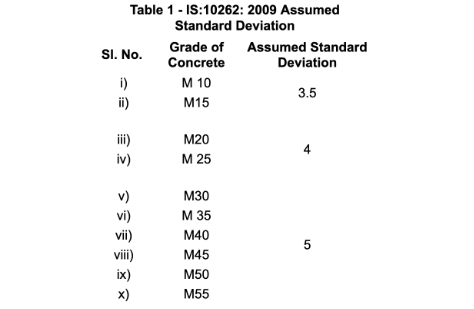
- Water cement ratio: In this step we select maximum w/c ratio, which should be as per Table 5 of IS – 456: 2000.
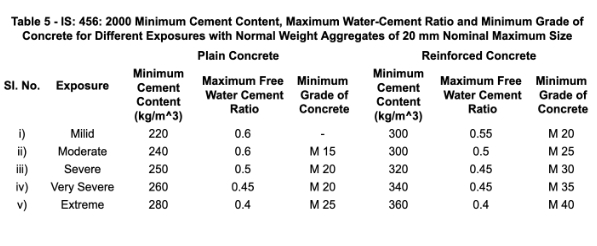
| Maximum water-cement ratio | 0.60 |
| Adopted water-cement ratio | 0.35 |
- Entrapped air: For the maximum size of aggregate used the air content is estimated.
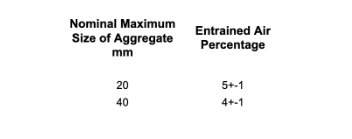
- Water content and fine to total aggregate ratio: The selection of water content is based on Table 2 of IS:10262:2009. Maximum water content for 20 mm aggregate and a slump value of 25 to 50 mm = 186.0 l. But in our problem the value of slump is 80 mm, so we need to alter the water content.
| Estimated water content | 186 + 3.6/100 X 186 = 192.70 litres |
- Cement content: The cement content per unit volume of concrete is computed sing Table 5 of IS:456:2000:
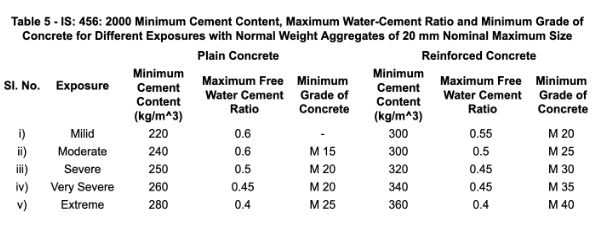
| Minimum cement content for mild expossure condition | 220 kg/ m3 |
| cement content | 192.70/0.54 = 356.85 kg / m3 |
- Aggregate content: Volume of coarse aggregate per unit volume of total aggregate for corresponding to 20 mm maximum size and zone IV of fine aggregate = 0.66 – Table 3 of IS- 10262:2009.
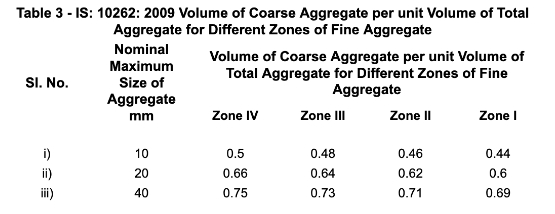
Correction on the volume of different ingredients
| Based on the water-cement ratio | 0.03 |
| Based on placement | 0.00 |
Hence Volume of
| Coarse aggregate | 0.69 |
| Fine aggregate | 0.31 |
$$
V=\left[W+\left(C / S_{c}\right)+(1 / P) \cdot\left(f_{a} / S_{f a}\right)\right] \times(1 / 1000)
$$
$$
C_{a}=1- P / P \times f_{a} \times S_{ca}/ S_{fa}
$$
| Mass of Coarse aggregate | 1195.85 kg / m3 |
| Mass of Fine aggregate | 537.27 kg / m3 |
Computation of actual quantities required for a concrete mix – Trial mix
Water Correction
The extra quantity of water to be added
| Coarse aggregate | 5.98 kg |
| Fine aggregate | 5.37 kg |
| Mix Design | |
| Cement | 357 kg / m3 |
| Water | 204 kg / m3 |
| Fine Aggregate | 532 kg / m3 |
| Coarse Aggregate | 1190 kg / m3 |
Concrete Mix Design
Take some time to enter the input data as per your problem and get the Complete mix design results in few seconds….

Mix design Result
Concrete Mix Design Just In One Click
Makes You Work Easier and Fast…
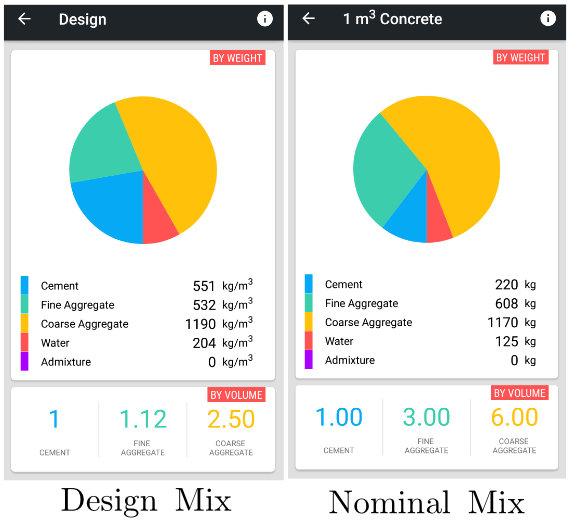
In order to check the efficiency of the designed mix, we shall prepare different trial mixes and the same are tested to check the strength and workability of the designed mix. If the designed mix fails to meet the desired properties, then a minor adjustment is done in the water-cement ratio and aggregate quantities; then again, the trial mixes are prepared.
Conclusions:
The nominal mix for M10 grade is (1:3:6). The quality of concrete depends on a number of factors and the standard mix just gives us a rough estimate of the quantities of material required, this is exactly where a design mix procedure is required as it is evident from the results that for the same mix proportion when exposure and material properties are changed mix proportion also changes. Therefore, standard mixes may be used only for very small jobs.
In this post, you learned the following key points:
- Concrete mix design: The proportions of the various ingredients in the mix determine the final properties and performance of the concrete.
- Indian standard code: Follow IS – 10262:2009 and IS- 456:2000 to do the concrete mix design efficiently.
- Concrete mix design application: You can do the concrete mix design in just one click using the concrete mix design application.
Hope this post helped you to learn the step-by-step procedure for concrete mix design using IS code ( IS – 10262: 2009 and IS – 456: 2000)
Concrete Mix Design
- Calculate cement, sand and aggregate quantity in concrete.
- Calculate the number of premix bags required for your project.
- Option to set your own size and rate of premix bags.
- Calculate the volume of concrete required for slabs, walls, footings and columns.
- Calculate the weight of ingredients required for preparing the calculated volume of concrete.
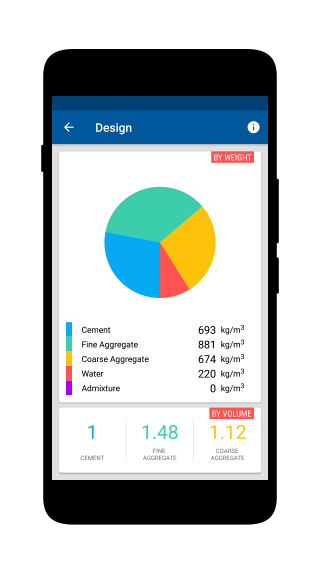
This article was crafted by a group of experts at eigenplus to ensure it adheres to our strict quality standards. The individuals who contributed to this article are:
Author



For M10 design mix, the cement calculated is 551kg/cubic meter which looks very high. As per IS 10262: 2009, the maximum cement content should not exceed 450 kg/cubic meter. The design mix ratio for the calculated quantities, is also found irrelevant
Thank you dear Seethalakshmi for pointing out the error in the calculation. We have updated the design. Please do check and suggest correction if any. Thank you for reading the article and contacting us.